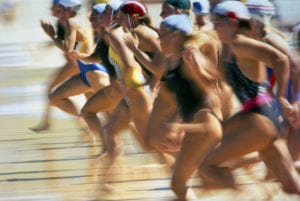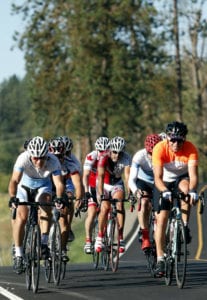Triathletes are the pinnacle of all the athletes. They have mastered the art of swim, bike and run and perform all three disciplines within one event during multiple different distances.
 I have always thought triathletes are the ones who have the cross training figured out. Running has a bad reputation for hurting our joints and causing muscle imbalance, but triathletes within their training program go from run to pool (which is usually the number one recommended activity by health care professionals to offload sore joints). And, if it is not a swim day then they bike which is also considered a low impact activity.
I have always thought triathletes are the ones who have the cross training figured out. Running has a bad reputation for hurting our joints and causing muscle imbalance, but triathletes within their training program go from run to pool (which is usually the number one recommended activity by health care professionals to offload sore joints). And, if it is not a swim day then they bike which is also considered a low impact activity.
So why did the recent research of over 300 female triathletes show the following findings? (data from The Official Journal of American Urogynecological Society)
- 37% reported symptoms of stress incontinence (leaking with cough, sneeze and jump)
- 16% reported urge incontinence (strong sensation to go to pee)
- 5% reported symptoms of prolapse (heaviness and pressure in pelvic area)
- 18% reported pelvic girdle pain
The lesson learned after reading these numbers is that triathlon is still a great sport but do not hesitate to seek a help of a Pelvic Health Physiotherapist. Stress incontinence has been reported as the main reason why women quit sport. A visit to a Pelvic Health practitioner can provide you with techniques to relax and strengthen your pelvic floor muscles and make them ready for impact activities.
 Cycling is a great sport for reducing heart diseases and prevent cancer but it has developed a bad reputation over the years for contributing to erectile dysfunction in males. To evaluate this, a recent study in Journal of Urology compared male runners and swimmers to cyclists. The study concluded that sexual and urinary health of cyclists is similar to runners and swimmers.
Cycling is a great sport for reducing heart diseases and prevent cancer but it has developed a bad reputation over the years for contributing to erectile dysfunction in males. To evaluate this, a recent study in Journal of Urology compared male runners and swimmers to cyclists. The study concluded that sexual and urinary health of cyclists is similar to runners and swimmers.
The key factor of possible genital numbness, pelvic pain and soreness is an improper bike fit. Lower handlebar position directly correlates with genital pain. Adjusting the handlebars to above or even with the bike seat as well as increasing the time standing out of saddle reduce the likelihood or genital soreness and/or numbness.
Cycling, and Male Sexual and Urinary Function: Results from a Large, Multinational, Cross-Sectional Study
Awad, Mohannad A. et al.
The Journal of Urology , Volume 199 , Issue 3 , 798 – 804
Here are few tips to incorporate into your routine to maintain healthy pelvic floor:
- Breathe: We live in times of deadlines, schedules and stress. It is very easy to not breathe properly. Pelvic floor muscles are connected to diaphragm through breathing. Before starting your training pause for a minute and make yourself to take few deep breaths in through your nose, out through your mouth. If you find it helpful, place your hands on your ribcage, and feel your ribs and diaphragm expand with inhalation, and contract with exhalation. Breathing helps relaxes tight pelvic floor muscles.
- Stretch your hips: Hip muscles encircle the pelvic floor. Stretching your hips will have a positive impact on the deepest muscles in your pelvic floor cavity. Yoga movements such as butterfly, pigeon or child’s poses can significantly reduce tension and pressure in your pelvis.
- Forget the Kegel: Do not clench your pelvic floor muscles during running or swimming. Poor technique of Kegel exercises leads to tightening of pelvic floor muscles and makes you more prone to leak or feeling pain.
Do you experience any of the mentioned symptoms? Book an appointment with a Pelvic Health Physiotherapist!






